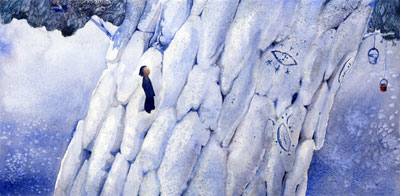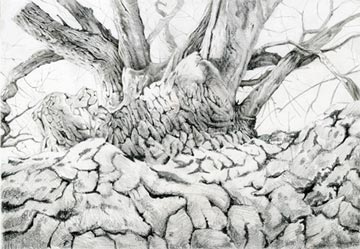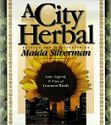Wild Herbs and Weeds:
An Appreciation in Four Seasons
by Maida Silverman
Standing at the window of my studio in early March--I live north of Milwaukee, close to beautiful Lake Michigan here in Wisconsin-- I watch the wind blow falling snow into high drifts, but the weeds are not quite defeated. I see tall brown stalks of last summer's Mullein, and stems of Milkweed. The plump shells of the milkweed pods are empty, their seed parachutes long gone. The nest-like cups of Queen Anne's Lace were all but empty of the pungent seeds they protected--but a few remained.
I watch the wind blow falling snow into high drifts, but the weeds are not quite defeated. I see tall brown stalks of last summer's Mullein, and stems of Milkweed. The plump shells of the milkweed pods are empty, their seed parachutes long gone. The nest-like cups of Queen Anne's Lace were all but empty of the pungent seeds they protected--but a few remained.
I saw Burdock, too-- a few prickly burrs still clinging here and there to the tall grey-brown stems. They stand up bravely--gusts of wins shake them, but they endure, long after pampered garden plants have vanished. Many such "weeds" were brought here by our herbalist foremothers. They were treasured as medicine and food in the strange new world that was forever to be their home.
Planted in Colonial gardens, these and other plants flourished, eventually escaped and spread throughout the new land. These plants are now treasured by all of us who have come to know, love and benefit from their usefulness. Admired and gathered for their benefits, we may get so caught up in gathering the roots, leaves, fruits and seeds in their proper season, that we often don't "see" the plant itself. I propose, as I wait for winter to end, to present an appreciation of a few of my favorites.
Mullein, in it's first year, is awakened by Spring and sends from the dry, sunny places where it likes to grow, a rosette of gray-green leaves that are soft--like flannel, or kitten's ears. If the rosette is in its second year, by mid summer, a tall stalk of the same gray-green color will reach towards the sun. Soon, bright yellow flowers will open along this stalk. Groups of Mullein, their stems starred with flowers, is one of the beautiful sights of summer. I hope you will stop and enjoy this regal herb when you go out to harvest the flowers for medicine.
Milkweed shoots are one of the early potherbs of Spring, along with Japanese Knotweed. If you remember where you saw their arching brown winter branches, and the stems of Milkweed silhouetted against the snowdrifts, you can return in Spring to gather the the tender shoots of both wild "weeds." They are among the most delicious wild pot herbs.
In Summer, as you gather other wild herbs, you will surely come upon these two: Milkweed has elegant oval leaves and clusters of fragrant, amazingly complex flowers.  If you are lucky, you'll see Monarch butterflies feeding on the flowers'nectar. The arching canes of Japanese Knotweed will be covered with upright branches of delicate white flowers. Please stop to admire and thank them for the beauty they share.
If you are lucky, you'll see Monarch butterflies feeding on the flowers'nectar. The arching canes of Japanese Knotweed will be covered with upright branches of delicate white flowers. Please stop to admire and thank them for the beauty they share.
As you add them to your herbalist's basket, pause to notice the refreshingly pungent aroma of Yarrow, and the honey-sweet fragrance of Red Clover. Stop to admire the many tiny flowers that are arranged as one on a Clover's slender stalk. Take note of the lace-like flowers of Elder and Queen Anne's Lace. No mortal craftswoman can hope to create so delicate a design.
Marvel at the Sumach--its branches look like the letter "Y." Let yourself be soothed and refreshed by the fresh-raspberry fragrance of the red berries as you gather the berry clusters for a cool, healthful summer drink.
The snow has melted. The calendar says it is Spring now--but winds still blow and the ground is very cold. I will have to wait a little longer for my beloved Dandelion--the faithful first green plant of Spring. I will admire and be thankful for its return--and rejoice in the knowledge that the other "weeds" I love will soon follow.
Copyright © 2009 by Maida Silverman
*The plants mentioned here are described more fully in "A City Herbal: Lore, Legend and Uses of Common Weeds" This book is written and illustrated by Maida Silverman and is published by Ash Tree Publishing. It can be ordered
from this website.

Maida Silverman was born and has spent her life in New York City. The fantasy of a garden of her own, overrun with fruit trees, nut trees, flowers, berries, vegetables, and herbs has not yet come to pass. Because of this she turned her attention to wild plants that grow in the city and found them rewarding and engrossing.

A
City Herbal
 by Maida Silverman. The wild plants of the city are
potent herbal medicines and nutritious wild edibles, as
well as sources of comfort, fiber, and dyes. Learn to recognize
and use 34 of them. 192 pages, index, illustrations.
by Maida Silverman. The wild plants of the city are
potent herbal medicines and nutritious wild edibles, as
well as sources of comfort, fiber, and dyes. Learn to recognize
and use 34 of them. 192 pages, index, illustrations.
Read a review
Retails
for $13.95
“A City Herbal by Maida Silverman is a delightful way to get acquainted with wild herbs that you have no doubt walked on or over without ever dreaming how useful they can be. It has increased my interest and curiosity a hundredfold and I’m sure it will do the same for you.” -James Beard
Order A
City Herbal in our Bookshop






 CORRESPONDENCE COURSES
CORRESPONDENCE COURSES 
